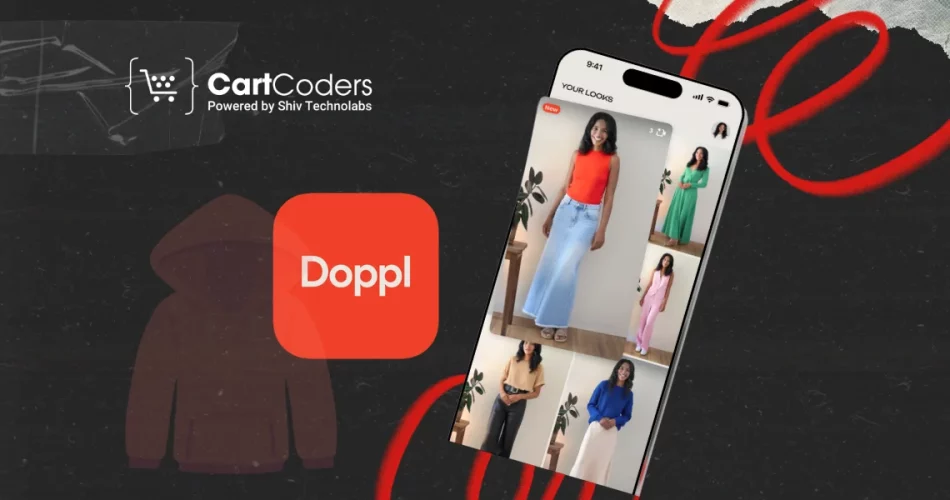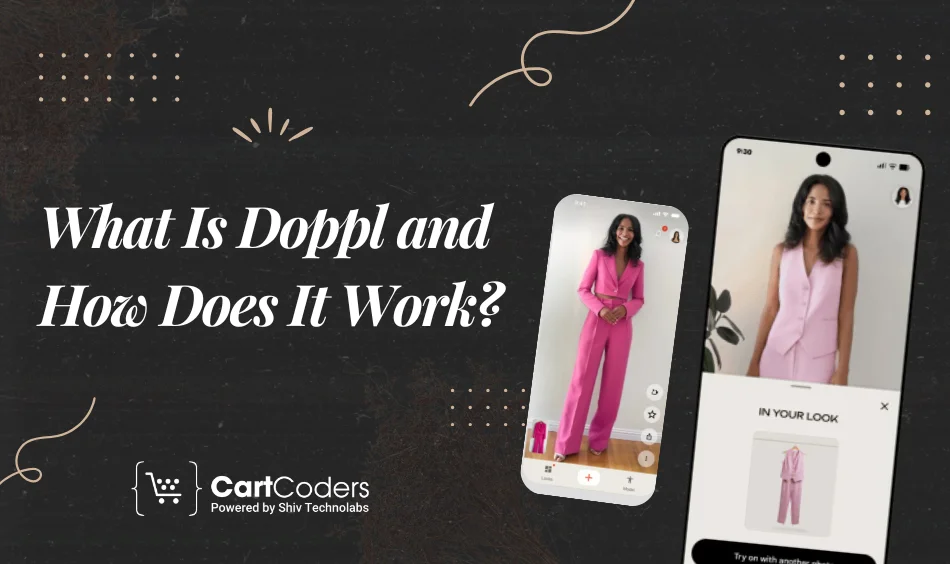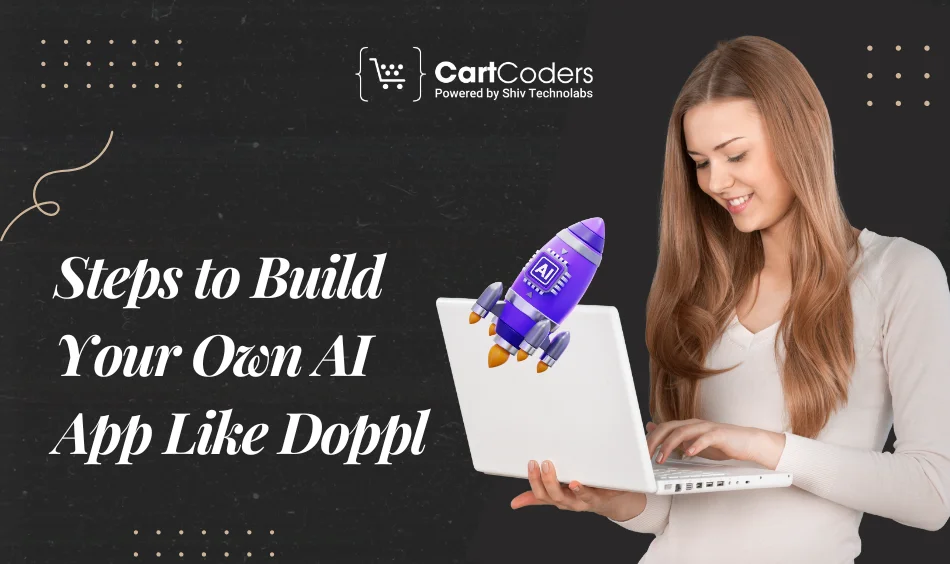Custom Engagement Solutions
Unlock tailored solutions with a free, no-obligation strategy session.
Expert Developers & Engineers on Demand
Scale Your Team with Skilled IT Professionals
Expert Guidance for Digital Transformation

AI photo apps have become the new favorite for users who enjoy sharing creative, personalized content.
One such app, Doppl, has made headlines by turning selfies into studio-like portraits using artificial intelligence. It’s fast, fun, and easy to use, which is exactly why it’s catching on with millions.
If you’re thinking about building an AI app for eCommerce, now is a great time.
In this blog, we’ll go over how Doppl works, what goes into making an app like it, and how much you might spend from idea to launch.
Google’s new app, Doppl, has captured widespread attention for offering a novel way to virtually try on clothes. The app creates short animations of users wearing outfits they upload—be it a photo from social media, a thrift shop screenshot, or something from a retail catalog—powered by Google’s generative AI.
While visuals aren’t always perfect—users have noted alignment glitches or misplaced textures—it still delivers a playful and surprisingly effective fit preview.
Reviewers have praised the app’s creativity and fun factor. One user called it “amazing… it lets you see what any clothes look like on your body and animate a photo,” apps.apple.com, though some reports also mention bugs, crashes, and limited usability for men or partial outfits.

Doppl is an AI-powered photo app by Google that creates realistic, animated portraits from a single photo. Instead of filters or templates, it uses machine learning to reimagine the user in different outfits, styles, and poses — almost like a digital fashion try-on.
Once you upload your image, Doppl’s system scans your face, body position, and visual cues. It then generates a short animation of you wearing the selected outfit, often styled like a fashion reel.
The output looks smooth, often realistic, and sometimes playful, depending on the image and clothing used.
While Google hasn’t officially shared the full tech breakdown, Doppl is likely powered by:
The real strength of Doppl lies in how little the user has to do, just one image, and the app does the rest.
If you’re planning to build something similar to Doppl, you’ll need more than just an AI model. The full user experience matters — from uploading photos to getting styled results.
Below are the must-have features if you wish to build an AI-powered fashion store.
Allow users to upload a clear selfie. Add basic tools to crop, center, or improve the image before sending it to the AI.
Offer multiple style options — such as studio portraits, cartoon looks, professional outfits, or casual clothing. These are generated based on user inputs or preset filters powered by AI.
Let users create accounts where they can save past renders, mark favorites, and view their style history. This also helps in offering personalized suggestions over time.
Monetization can be built around paid styles, download credits, or monthly plans. Start with free trials, then introduce coins or tier-based pricing for more advanced outputs.
Depending on how heavy the AI processing is, either offer near-instant results or let users wait while the image is processed in the background. Show loading indicators and allow users to come back later if needed.
For More Details: Features To Make Your Fashion Store Standout
An app like Doppl may look simple on the surface, but under the hood, it depends on several advanced AI techniques. These tools work together to turn a static selfie into a styled, animated result.
Doppl likely uses Stable Diffusion or GANs (Generative Adversarial Networks) to generate new images. These models are trained on large datasets and can produce realistic visuals based on prompts or visual cues.
Before styling can begin, the app must detect and align key facial and body points. This helps the AI understand where the eyes, nose, shoulders, and hips are, so it can apply clothing and motion more accurately.
Once the base image is generated, a style layer adds effects like texture, lighting, or outfit color. Post-processing tools then clean up the results to make them look polished and lifelike.
To create short animated clips, Doppl may use AI motion generation tools that simulate natural movement. These systems work like puppeteering — they shift the user’s pose and apply it across a few frames.
All these parts are powered by high-performance GPU infrastructure, often cloud-hosted, to handle the demands of real-time or large-scale rendering.

Building an AI app like Doppl takes careful planning. From choosing the right tools to launching a working product, here’s how you can break it down:
Start by testing different models like Stable Diffusion, DALL·E, or GANs. Check how they perform with face inputs and clothing overlays. Try both open-source options and paid APIs to compare speed, quality, and flexibility.
Pick tools based on your team’s skills and app goals.
For faster development, start with ready-made APIs like Replicate or DeepAI. If you want full control over quality and speed, consider training your model using custom datasets.
Design a simple interface with features like:
Make it feel quick and interactive, with clear loading states and helpful prompts.
Offer limited free trials or sample styles. After that, introduce pricing with:
Before launch, test your app with real users to catch bugs and improve speed. Early feedback is key to building a smooth experience.
The cost of building an AI app like Doppl depends on the features, quality of AI, and infrastructure you choose.
A basic version might cost far less than a full-scale app with real-time animations and global reach.
Here’s a rough breakdown:
| Component | Estimated Cost (USD) |
| MVP App Build | $8,000 – $15,000 |
| Full Feature App | $20,000 – $50,000+ |
| AI Model Training | $5,000 – $25,000 (one-time) |
| Cloud GPU Hosting | $300 – $1,000/month |
| Third-party AI APIs | $0.01 – $0.10 per image (if used) |
| UI/UX Design | $2,000 – $5,000 |
| QA & Testing | $1,000 – $3,000 |
Start with a prototype using third-party APIs. If the app gains traction, move to custom-trained models for better speed and control.
Also, keep in mind ongoing expenses like cloud hosting, storage, and support.
Once your AI face app is ready, the next step is to turn users into paying customers. Doppl-style apps are well-suited for visual-based monetization. Here are the most effective ways to earn:
Let users try basic styles for free. Then, offer premium outputs like HD portraits, videos, or rare styles as paid upgrades.
Sell credits that users can spend per photo or animation. This model gives more flexibility and works well for occasional users.
Offer monthly or yearly subscriptions that include unlimited generations, early access to new styles, or bonus features.
If you’re targeting a wide audience, run ads for non-paying users. Use this only if the ad flow doesn’t affect user experience.
Partner with fashion brands or creators to add exclusive styles and earn through sponsorships or affiliate models.
If you’re planning to build an AI-powered app like Doppl — whether for fashion, face styling, or virtual try-ons — you don’t need to start from scratch. At CartCoders, we help brands turn smart ideas into working AI-based products.
From user-friendly mobile apps to AI-backed tools for Shopify stores, we bring together design, AI tech, and experience to deliver fast, smart, and polished digital products.
Looking for something ready-made?
Check out our AI Fit Finder Shopify App — a smart sizing tool that helps customers find the right fit using body data and product measurements. It reduces returns and builds shopper trust in fashion and apparel stores.
Whether you’re building a full app or want to add AI features to your store, CartCoders has the tech team to bring it to life.
Doppl has shown how fun, fast, and creative an AI app can be. By turning a single photo into a styled, animated result, it gives users something exciting to share and businesses a fresh way to connect with audiences.
If you’re thinking about building something similar, start with a clear plan: the right tech stack, smart design, and a focus on user experience. Whether you’re launching a mobile app or adding AI to your Shopify store, there’s real potential in combining visuals and automation.
At CartCoders, we’re already helping eCommerce brands use AI in ways that make a difference, like with our AI Fit Finder app. If you’re ready to build your AI-driven product, we’re here to help.
Doppl is a photo app by Google that turns your selfie into a short animation where you’re wearing different outfits.
It uses artificial intelligence to style your photo with clothes, poses, and effects, all from just one image. The app is designed for people who want to try new looks without changing clothes or visiting a store.
Yes, you can. With the right tools and a skilled development team, it’s possible to build your AI-powered app.
Whether you want to create something fun like Doppl or a tool for online shopping, you can start with existing AI models and work with developers to bring your idea to life.
Yes. Doppl is one example where users can see themselves in different outfits using just a photo. There are also apps by fashion brands that offer virtual try-on features using live camera filters or uploaded images. These apps help people check how clothes might look on them before buying.
If you run a fashion store on Shopify, you can use the AI Fit Finder app by CartCoders. It helps shoppers pick the right size based on their body measurements and product data.
This not only improves customer experience but also helps reduce size-related returns.
Projects delivered in 15+ industries.
95% retention rate, building lasting partnerships.
Serving clients across 25+ countries.
60+ pros | 10+ years of experience.